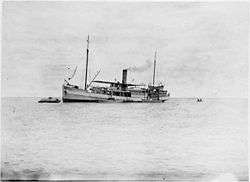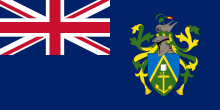British Western Pacific Territories
The British Western Pacific Territories (BWPT) was the name of a colonial entity, created in 1877, for the administration, under a single representative of the British Crown, styled High Commissioner for the Western Pacific, of a series of Pacific islands in and around Oceania. Except for Fiji and the Solomon Islands, most of these colonial possessions were relatively minor.
British Western Pacific Territories | |
|---|---|
| 1877-1976 | |
 | |
| Status | Colonial entity |
| Capital | Suva 1877–1952 Honiara 1952–1976 |
| Common languages | English (official)
Fijian, Tongan, Gilbertese various Austronesian languages regionally |
| Government | Constitutional monarchy, colony |
| High Commissioner | |
• 1877–1880 | Sir Arthur Hamilton-Gordon (1st) |
• 1973–1976 | Sir Donald Luddington (23rd and final) |
| Chief Judicial Commissioner | |
• 1877–1882 | Sir John Gorrie (1st) |
• 1965–1975 | Sir Jocelyn Bodilly (14th and final) |
| Historical era | 19th and 20th Centuries |
• Western Pacific Order in Council | 13 August 1877 |
• Dissolution | 2 January 1976 |
| Currency | British pound sterling |
| Today part of | |
History
The Pacific Islanders Protection Act 1875 (38 & 39 Vic c51), then later, the Foreign Jurisdiction Act 1890 (53 & 54 Vic c.37), provided for jurisdiction over British subjects in the Pacific.[1] In 1877 the position of Western Pacific High Commissioner was formalised by the Western Pacific Order in Council 1877 by the Privy Council of the United Kingdom.[1] Article 12 established the Chief Justice of Fiji as the Judicial Commissioner for the Western Pacific.[1][2] The Order In Council created the colonial entity – the British Western Pacific Territories – and granted the authority to manage the engagement of indentured labourers and to otherwise give the colonial entity authority over British subjects in the Western Pacific beyond the jurisdiction of British and colonial Australian laws.[1]
The Governor of Fiji was given authority over persons and acts in the islands south of the equator. The Governor, as High Commissioner and Consul-General, was given the authority: to conduct diplomatic relations with local representatives of the foreign powers, to regulate the labour trade where it was conducted by British subjects only, and to maintain law and order among British subjects in the Pacific islands where there were no recognised governments.[1] The High Commissioner appointed Resident Commissioners to manage specific island territories. Following a commission of inquiry as a revised Order in Council was issued in 1893, which gave the Resident Commissioners wider autonomy over the islands under their control.[1]
The composition of the territories of the BWPT varied over time. The most durable members were Fiji (from 1877 to 1952) and the Solomon Islands (from 1893 to 1976). Between 1942 and 1945, the high commission was suspended. While most islands were under British military administration, the Solomon Islands and Gilbert Islands came under Japanese occupation.
In 1952, Fiji was separated from the High Commission. Following this, the High Commissioner's post moved to Honiara in the Solomon Islands, and the High Commissioner was also the Governor of the Solomon Islands. The High Commissioner's Court, however, continued to meet in Suva, with the Chief Justice of Fiji continuing as Chief Judicial Commissioner for another decade, until 1962, when the two offices were separated. Under the Western Pacific (Courts) Order in Council, gazetted on 15 August 1961 and effective from 9 April 1962, the High Commissioner's Court was renamed the High Court of the Western Pacific and relocated to the Solomon Islands.[2] The court consisted of a Chief Justice (as the office of Chief Judicial Commissioner was renamed) and two puisne judges, one based in Port Vila, New Hebrides (now Vanuatu), and the other in Tarawa, Gilbert and Ellice Islands (now Kiribati and Tuvalu).
Most of the island groups had gained either independence or internal self-government by 1971. On 1 January 1972, the Gilbert and Ellice Islands were taken off with their own Governor. On 2 January 1976 after nearly all had been given separate statehood, the office of High Commissioner and the entity of the Pacific Territories were abolished. A remnant of the High Commission, however, was the right of appeal from the courts of many island nations to the Fijan Court of Appeal, which persisted into the late 1970s.[3] With the independence of Kiribati in 1979, all islands formerly a part of the Territories (except the Pitcairn Islands) had either gained independence or been attached to other entities.
In 2002 the archived records of this High Commission were transferred to New Zealand, and are now held in the Special Collections of the University of Auckland Library.[4]
Island groups

.svg.png)
In Polynesia



- Phoenix Islands (to 1939) The nearly uninhabited eight atolls are presently part of Kiribati



In Micronesia

In Melanesia
.svg.png)
.svg.png)
.svg.png)
See also
- High Commissioner for the Western Pacific, with incumbents list
Sources, references and external links
- Lawrence, David Russell (October 2014). "Chapter 5 Liberalism, Imperialism and colonial expansion" (PDF). The Naturalist and his "Beautiful Islands": Charles Morris Woodford in the Western Pacific. ANU Press. ISBN 9781925022032.
- "Judicial System". Solomon Islands Historical Encyclopaedia 1893–1978. Retrieved 20 August 2015.
- Justice Gordon Ward (2005) Achieving effective legal representation in small Pacific island Commonwealth States Archived 31 March 2011 at the Wayback Machine. Commonwealth Law Conference, London, September 2005
- "Western Pacific Archives". University of Auckland. Retrieved 2 February 2016.
- Maslyn Williams & Barrie Macdonald (1985). The Phosphateers. Melbourne University Press. p. 11. ISBN 0-522-84302-6.
- Ellis, Albert F. (1935). Ocean Island and Nauru; Their Story. Sydney, Australia: Angus and Robertson, limited. p. 29. OCLC 3444055.
- WorldStatesmen
- Deryck Scarr, Fragments of Empire. A History of the Western Pacific High Commission. 1877–1914, Canberra: Australian National University Press & London: C. Hurst & Co., 1967.
.svg.png)